Welcome to SleepTimer Ultimate.
Feature rich freeware shutdown timer on Windows XP and above
No viruses. No malware. No spam.
Current version: 2.5.1
Freeware
SleepTimer Ultimate is free. It can shutdown the computer after a defined time. Minimum requirement is a Windows XP system. Windows 10 is supported as well. SleepTimer can do other things if the time is reached and is customizable. SleepTimer Ultimate is a private hobby project – there are no commercial intentions. It is and will be free. As a result of the first programming lessons it will be developed further from time to time. In future there will be updates with new features and improvements.


Features
SleepTimer has lots of functionalities
WHAT SLEEPTIMER CAN DO
- Shutdown
- Restart
- Power-off
- Lock screen
- Logout
- Hibernate
- Standby / wake up
- Stop multimedia
- Launch program
- Terminate programs
- Disconnect Bluetooth devices
- Start computers (WOL)
NOTIFICATIONS BEFORE ACTION
- Audio
- Voice output
- Screen overlay
- Balloon hint
WHEN SLEEPTIMER CAN DO
- Immediately
- Hour time
- Date / time
- Countdown (Hour:Minute)
- Idle since (Hour:Minute)
- If window appears
- If CPU > or< load
- Planned
- IF network traffic drops
- If window disappears
MUCH CUSTOMIZATIONS
- 39 Skins (Themes)
- Autostart
- Portable
- Multiple languages
- Password protection
SCREENSHOTS
For a quick overview
FAQ
Frequently asked questions
Since version 1.2 it is possible to let SleepTimer start with Windows automatically. There is an option in the preferences. After activation of this option SleepTimer will start with the last used time and action automatically with Windows startup or resume from standby. You can also make an shortcut in Autostart and pass the parameter «FORCE» (without quotation) to the EXE.
Since version 2.2 it is possible to create shortcuts which you can copy to the Windows Autostart folder.
With Windows 10 you just use the keybord keys «Windows» + «R». There you type
the command «shell:startup» and ENTER. It is opening the Autostart folder for the user, where you can copy the shortcut file into it.
Shortcuts in SleepTimer can create with main menu «Help» and «Create shortcut». It is possible to create a shortcut for countdown or a profile, to use it for Autostart.
Sometimes the autostart option cannot be activated. It can be that a protection software prevent this. Autostart will be activated in the userspace of Windows registry. Some protection software don’t let to do so. You could try so set SleepTimer as trusted.
UPDATE: With the new included AutostartHelper.exe this information is deprecated.
If you set SleepTimer to autostart, it is possible to protect SleepTimer from user actions through a password. See Autostart section in preferences.
SleepTimer doesn’t need an internet connection. You can download and copy it to an USB stick, and install it at another computer.
Ab sofort hat SleepTimer eine Funktion, die auf neue Updates / Versionen prüft. Das passiert aber nicht automatisch, dazu muss der entsprechende Menüpunkt geklickt werden. SleepTimer «telefoniert» also nicht automatisch «nach Hause».
You can copy the SleepTimer directory to an USB stick or other portable device. The preferences file will be saved in the directory of the EXE.
You can check for updates in the main menu. If an update available you download the intall version or ZIP archive. The installer will overwrite all old files with the new ones. If you use ZIP archive, unpack the files and copy it over the old. The preferences file will be stille there and updated with new entries.
In general settings you can activate «Use profiles». After restart of SleepTimer there is an option group «Profiles» availabale.
Settings like action or time can be saved as a profile. You can also load this profile in this menu.
You can use profiles for autostart. With main menu «Help» and «Create shortcut» you can create a shortcut that you can copy in the autostart folder of Windows. More infos in the FAQ «Is it possible let SleepTimer start automatically?»
The skin files have file extension named .vsf and are located in the following folder:
C:\Program Files (x86)\SleepTimer Ultimate\skins
You must create a new file called «ENABLE_ALERT_ONLY» (without file extension) in the app folder of SleepTimer. On the next start of the app new option «Alert» will be available. App folder is located C:\Program Files (x86)\SleepTimer Ultimate.
The German translation needs a language file with file extension .mo which is located after intallation or in ZIP archive in «locale» folder. The whole folder «locale» must be present in the same folder as SleepTimerUltimate.exe. Then the language will be set properly.
ANDROID
Sleeptimer also available for Android
LATEST NEWS
Stay up-to-date on SleepTimer
Version 2.5.1
New version available. Wake on LAN (WOL) is working again. Here is the Download: SleepTimer Ultimate 2.5.1
Version 2.5
New version 2.5 available. Many Bugfixes and improvements. New changes can be found here: Changelog Download can be found here: Download
Version 2.4.1
New time option: “On window title text disappear” New multimedia option: “Close current Edge tab” Several bugfixes. Have fun! Here…
Version 2.4
It is a new version of SleepTimer Ultimate available. After a long time without PC and support I managed to work…
Version 2.3
It is a new version of SleepTimer Ultimate available. The new main feature is the work with profiles. You can save…
CONTACT
Feature request or found a bug?
Sleep Timer
Sleep Timer is a powerful and easy to use computer software program that allows users to customize their computer’s sleep settings. With Sleep Timer, users can set their computer to sleep after a given amount of time. The program also provides users with the ability to adjust the amount of time before their computer sleeps, the type of sleep mode the computer will enter, and a wide range of additional settings.
Sleep Timer is designed to be simple to use and efficient. Users can quickly set their computer to sleep by following a few simple steps. The program allows users to set their computer to sleep after a set amount of time, allowing them to save energy and preserve the life of their computer. In addition, Sleep Timer can also be used to set a manual sleep mode, allowing users to manually put their computer to sleep at any time.
Sleep Timer also provides users with the ability to customize the sleep settings of their computer. Users can adjust the amount of time before the computer goes to sleep, the type of sleep mode the computer will enter, and a wide range of additional settings. This allows users to tailor the sleep settings of their computer to their individual needs.
Finally, Sleep Timer also provides users with the ability to monitor their computer’s sleep settings. The program can be used to view a detailed log of the sleep settings on the computer, allowing users to easily monitor how their computer is being used.
Features of Sleep Timer
• Set your computer to sleep after a given amount of time.
• Set a manual sleep mode.
• Customize the sleep settings of your computer.
• View a detailed log of the sleep settings on the computer.
• Efficient and easy to use.
• User friendly interface.
• Adjust the amount of time before the computer goes to sleep.
• Choose the type of sleep mode the computer will enter.
• Wide range of additional settings.
• Set alarms to remind users to put their computer to sleep.
• Automatic updates available.
• Compatible with Windows and Mac operating systems.
The Sleep Timer feature allows users to set a time limit for their music to stop playing automatically.
1. Compatibility: The sleep timer software should be compatible with operating systems including Windows XP, Vista, 7, 8, 10, Mac OS X 10.5 or higher.
2. User Interface: The software should have a user-friendly interface that enables users to easily set the timer and manage their sleep schedule.
3. Customization: The user should be able to customize the timer to fit their individual needs. This includes setting the length of the timer, setting alarms, and setting reminders.
4. Security: The software should be secure and protect user data from unauthorized access.
5. Backup: The software should have a backup feature to ensure that the user’s data is not lost in the event of a computer crash.
6. Update: The software should be regularly updated to ensure that it remains compatible with the latest operating systems and security protocols.
Automatically stops music, enhancing battery life.
User-friendly interface, easy to operate.
Customizable to fit individual sleep patterns.
Limited customization options for different sleep schedules.
Potential to disrupt ongoing tasks due to abrupt shutdown.
May not function reliably on all operating systems.
👨💻️ USER REVIEWS AND COMMENTS 💬
image/svg+xmlBotttsPablo Stanleyhttps://bottts.com/Florian Körner
Fraser N.
I recently tried out the Sleep Timer software and found it to be very useful! It was surprisingly easy to use and I liked that I could adjust the timer to the exact amount of time I needed. I also liked that it had customizable sounds and gave me the option to turn off the music after the timer was finished. The visuals were also attractive and the app ran smoothly. On the downside, it didn’t have any advanced features such as the ability to set multiple timers or to have the timer run automatically at certain times. Overall, I found the Sleep Timer software to be a helpful tool for my daily routine.
image/svg+xmlBotttsPablo Stanleyhttps://bottts.com/Florian Körner
Aaron Y.
Sleep Timer is a great tool for those who need to set a specific amount of time for a task. I like that I can set the timer for any desired amount of time, from a couple of minutes to a few hours. It’s very easy to use; it’s very intuitive and the interface is user-friendly. The sound quality for the alarm is quite good and it’s loud enough to be heard from another room. It also offers different alarm sounds to choose from.
image/svg+xmlBotttsPablo Stanleyhttps://bottts.com/Florian Körner
Harris R.
This software is really conveneint and usefull for those who have trouble falling asleep.
image/svg+xmlBotttsPablo Stanleyhttps://bottts.com/Florian Körner
Robbie Thorngren
Sleep Timer software is a program that allows users to set a timer for their computer to automatically shut down or go to sleep mode after a certain period. This software is designed to help users save energy, prevent damage to their hardware, and ensure that they get enough sleep. Its main features include customizable timer settings, automatic shutdown options, and the ability to override the timer if needed. With Sleep Timer software, users can have peace of mind knowing that their computer will not stay on longer than necessary.
image/svg+xmlBotttsPablo Stanleyhttps://bottts.com/Florian Körner
Mason
Simple to use, effective timing, customizable settings.
image/svg+xmlBotttsPablo Stanleyhttps://bottts.com/Florian Körner
Harry
Convenient, uncomplicated bedtime routine helper.
«Easily customize your computer’s sleep»
It is a powerful and easy-to-use computer tool that allows users to customize their computer’s sleep settings. One can determine how long the computer should remain active before entering sleep mode. In addition, the application offers the ability to adjust the amount of time before the computer goes to sleep, the type of sleep mode to use, and a variety of other settings. It is designed to be simple and efficient. One can quickly put the computer to sleep by following a few simple steps. Moreover, its features allow for displaying a detailed log of the computer’s sleep settings, thus providing an easy way to monitor how the computer is being used.
Выберите вариант загрузки:
- скачать с сервера SoftPortal
Таймер сна — если вы любите засыпать под музыку или любимое кино, то это программа для вас! Это таймер выключения компьютера с функцией плавного приглушения звука (полное описание…)

Рекомендуем популярное
PowerChute Personal Edition 3.1.0
PowerChute Personal Edition — Простое в использовании средство организации корректного завершения работы, обладающее развитыми функциями управления электропитанием…
BatteryInfoView 1.26
BatteryInfoView — небольшая бесплатная утилита, которая отображает текущее состояние батареи…
BatteryCare 0.9.36.1
BatteryCare — удобная программа, которая производит мониторинг циклов заряда/разряда…
WakeMeOnLan 1.93
WakeMeOnLan — небольшая бесплатная утилита, которая позволяет удаленно включить один или…
Setting a sleep timer on Windows 11 is a simple way to manage your computer’s power usage and make sure it rests when not in use. To set it up, you’ll navigate through the Settings menu, access the Power & Sleep settings, and choose when you want your computer to go to sleep automatically. This feature is particularly useful if you’re prone to leaving your PC on for long periods.
Setting a sleep timer on Windows 11 allows your PC to automatically enter sleep mode after a set amount of idle time. This process is straightforward and can help save energy and prolong your device’s lifespan.
Step 1: Open Settings
Press the Windows key and select the “Settings” icon from the Start menu.
Opening the Settings menu is your gateway to customizing various features on your Windows 11 PC, including power settings. It’s the control center for all your system configurations.
Step 2: Navigate to System
Within Settings, click on “System.”
The System section contains a variety of options related to display, sound, and power settings. This is where you’ll find the tools to adjust how your computer operates.
Step 3: Select Power & Sleep
In the System menu, choose “Power & Sleep” from the list.
The Power & Sleep section is specifically designed for managing energy consumption and performance. Here, you’ll dictate how and when your PC sleeps.
Step 4: Adjust Sleep Timer
Under Sleep, set the timer for when your PC should sleep during inactivity for both battery power and while plugged in.
Adjusting these settings allows you to tailor the sleep function to your habits and needs. You can specify different durations for when your device is on battery versus plugged in, optimizing performance and energy use.
Step 5: Save Settings
Close the Settings window to apply your changes.
Once you’ve adjusted the sleep settings to your preference, closing the window ensures that your new settings are saved and will take effect.
After completing these steps, your Windows 11 PC will enter sleep mode according to the times you set. This means your computer will conserve energy and improve its longevity by not being active when it’s not needed.
Tips for Setting a Sleep Timer on Windows 11
- Consider Usage Patterns: Set longer sleep timers if you’re frequently away from your desk for short periods and shorter timers if absences are lengthy.
- Monitor Battery Levels: Use shorter sleep timers on battery power to conserve energy.
- Regular Adjustments: Update sleep settings as your routine or usage needs change.
- Test Settings: Ensure the sleep timer functions as expected to avoid data loss.
- Use Sleep Mode Wisely: Sleep mode is great for pauses but shut down your PC for longer breaks.
Frequently Asked Questions
What is the difference between sleep and hibernate?
Sleep mode uses a small amount of power to keep your session active, while hibernate saves your session to the hard drive and uses no power.
Can I set different sleep times for battery and AC power?
Yes, Windows 11 allows you to set different sleep times for when your device is plugged in or running on battery.
Why won’t my computer sleep according to the timer?
Check for running background apps or processes that might be preventing sleep, and adjust settings as necessary.
How do I wake my PC from sleep?
Press a key on your keyboard or move the mouse to wake your PC from sleep mode.
Is sleep mode harmful to my PC?
Sleep mode is not harmful and is designed to conserve energy while keeping your session readily accessible.
Summary
- Open Settings.
- Navigate to System.
- Select Power & Sleep.
- Adjust Sleep Timer.
- Save Settings.
Conclusion
Managing your computer’s power settings, like setting a sleep timer on Windows 11, is a small but significant step towards efficient computing. By configuring your sleep timer, you ensure energy conservation, which not only helps the environment but also prolongs the lifespan of your device. Whether you’re stepping away for a meeting or calling it a day, knowing that your PC will power down automatically brings peace of mind.
As technology evolves, it’s essential to adapt and make use of available tools to make our lives easier. Sleep timers are just one of many features designed to enhance your user experience. If you ever find yourself needing to tweak these settings, remember it’s just a few clicks away. Explore the settings further to discover other tweaks and tips that can help optimize your Windows 11 experience. After all, a well-rested computer is much like a well-rested mind—ready to tackle whatever comes next.
Matthew Burleigh has been writing tech tutorials since 2008. His writing has appeared on dozens of different websites and been read over 50 million times.
After receiving his Bachelor’s and Master’s degrees in Computer Science he spent several years working in IT management for small businesses. However, he now works full time writing content online and creating websites.
His main writing topics include iPhones, Microsoft Office, Google Apps, Android, and Photoshop, but he has also written about many other tech topics as well.
Read his full bio here.
If you are working on your laptop and have to move away for a while, you should put it to sleep ideally. This way you can pick up your work from where you left it, also, it saves electricity and your laptop’s battery. However, if you have to leave your PC for a long duration, it’s not advisable to put it to sleep, in that case, you can schedule a sleep timer shutdown.
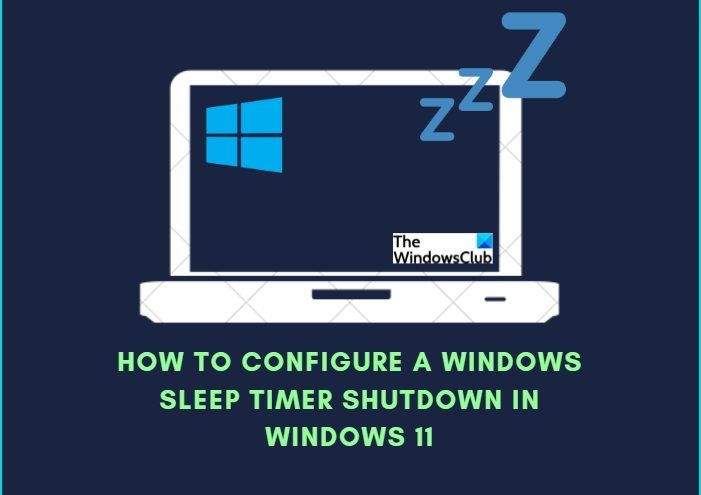
Well, in today’s post, we will learn about how you can set a Windows sleep timer to shut down your computer automatically after a certain period. but first, let’s talk about what is sleep mode on Windows 11 PC.
What is Sleep mode in Windows 11 PC
Putting your PC into Sleep mode is similar to pausing a playing DVD. When you put your PC into sleep mode, all the actions happening on your computer stop and move to your RAM, which means your system memory. Your computer is still on but it uses less power in this state. Your work will be resumed once you touch or move your cursor. So, if you are moving away for a longer duration keeping your PC to sleep, it’s better to schedule a sleep timer shutdown. You can read about the different System Sleep States here.
You can create a Windows Sleep timer shutdown in your Windows 11/10 PC using the Command Prompt or by creating a Desktop shortcut as follows.
1] Using Command Prompt

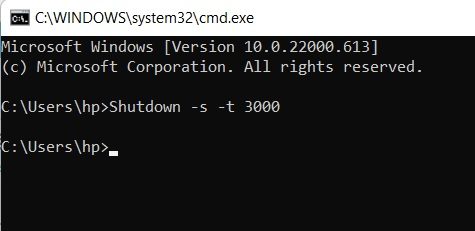
- Press Win+R to run the dialog box and type CMD to run Command Prompt.
- Type in the command,
Shutdown -s -t 3000and hit Enter. - Here, -s is giving the command to shut down and -t is the number of seconds, you want it to wait.
- Of course, you can change the timings as per your own requirements.
2] Create a Desktop Shortcut
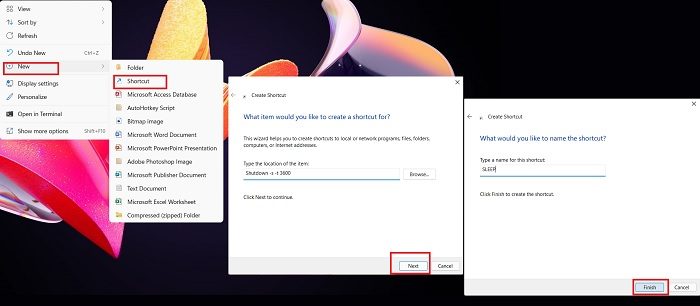
This method is for someone who wants to use this sleep timer shut down regularly. You can do this simply by creating a desktop shortcut without even opening the Command Prompt.
- This is again a very simple and quick way of creating a sleep timer for your Windows 11 PC.
- Go to your Desktop and right-click anywhere.
- Select New–>Shortcut.
- This will open a new window, type in the command, “Shutdown -s -t 3600″ and click on Next.
- Give the shortcut a name and click on Finish.
- You will get a shortcut on your Desktop as shown in the screenshot below.
You can cancel this sleep shutdown command anytime you want.
- Go to the Desktop and right-click.
- Select New -> Shortcut
- Type in the command below-
- Shutdown -a
- Type the name for this shortcut and click on Finish.
Related tip: If you are using a laptop, make sure to thoroughly understand the Pros and Cons of each Power plan, and then change the Sleep settings.
3] Create Windows Sleep Timer Shutdown using Run Command in Windows 11/10
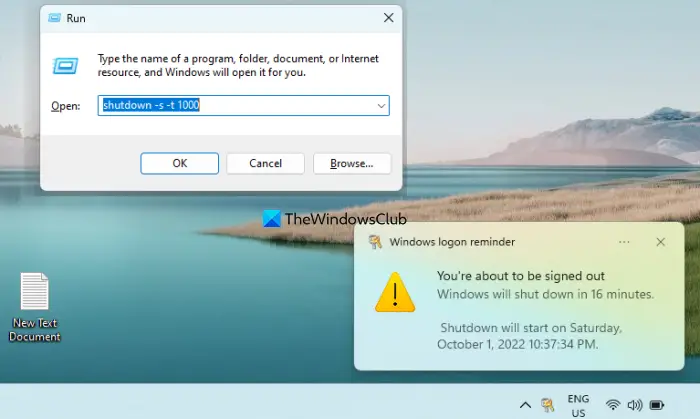
You can also use the Run Command box to create a sleep timer shutdown for your Windows 11/10 computer. These are the steps:
- Press Win+R hotkey. This will open the Run Command box
- Type
shutdown -s -t -1000command. While the s parameter is for shutdown and the t parameter is for the timer. You can change 1000 with any other value you want to set the timer - Press the OK button or use the Enter key.
You will get a desktop notification or Windows logon reminder (like visible in the screenshot above) that You’re about to be signed out and your Windows will shut down at the time set by you.
In case you changed your mind and want to cancel the shutdown, then open the Run Command box, type shutdown -a command, and hit the OK button.
4] Schedule Windows Shutdown using Task Scheduler in Windows 11/10
You can also follow a manual process and schedule shutdown using Task Scheduler in Windows 11/10. For this, you need to create a new basic task in Task Scheduler, give it a name, set the date and time for the task to trigger, and set the shutdown command. Once the task is scheduled, it will automatically trigger at the scheduled time and shut down your system.
5] Use a third-party tool like SleepTimer Ultimate or Sleep Timer
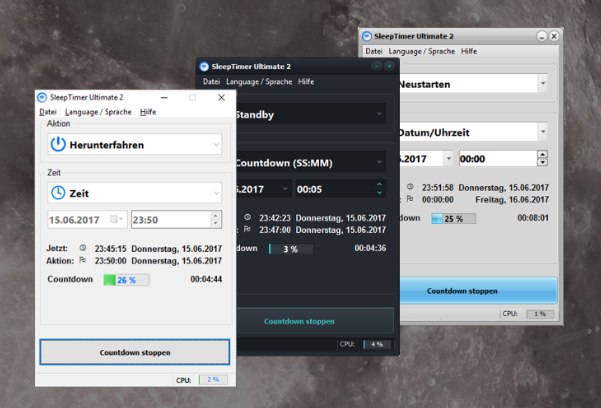
SleepTimer Ultimate is a free sleep timer program that allows you to shut down, restart, power off, Lock screen, Log out, Hibernate, Standby, Wake up, Start computers, etc.
You can also use other free shutdown scheduler tools or computer shutdown timer software to create a Windows sleep timer shutdown without any hassle. Simple Shutdown Timer, Windows Reboot, Adios Shutdown Timer, Sleep Timer, etc., are some good options to use. These tools let you set a timer in hours, minutes, and seconds to shut down or restart the system.
How do I change Sleep settings on Windows 11?
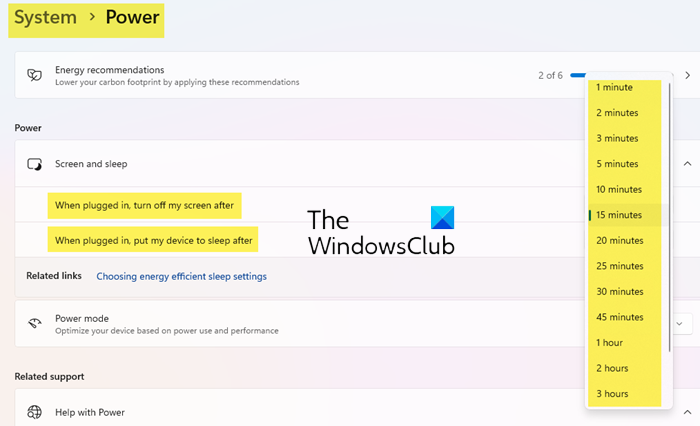
To change Power & sleep settings in Windows 11 do the following:
- Press Win+I key together to open the settings.
- Click the System entry under the side panel on the left.
- Switch to the right and scroll down to Power & battery option.
- Expand the menu and go to the Screen and sleep heading under Power section.
Here, you can choose how long you want the computer to wait before going to sleep. You can also change Sleep Timeout using PowerCFG command line.
How do I set a shutdown timer in Windows 11/10?
If you want to set a shutdown timer in your Windows 11/10 computer, then you can do it using Task Scheduler, Command Prompt, Run Command box, third-party tools, etc. All these options are covered in this post. Check these options and use any option you want to schedule a shutdown timer in Windows 11/10.
Does Windows 11 have a sleep timer?
You have to do that manually in Windows 11. Go to Settings > Power & Battery and customize your sleep settings. Alternatively, you can use the shortcut ALT+F4 and select the Sleep option from the menu.
Where is the Sleep button in Windows 11
Click on the Start, go to the power button in the bottom right corner, select Sleep and you are done. Also, you can press Alt+F4 and select the Sleep option from the menu.
